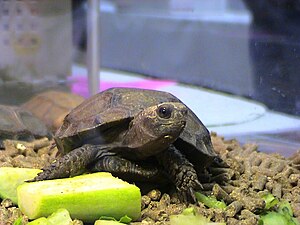Brown tortoise
| Brown tortoise | ||||||||||||
|---|---|---|---|---|---|---|---|---|---|---|---|---|

Brown tortoise |
||||||||||||
| Systematics | ||||||||||||
|
||||||||||||
| Scientific name | ||||||||||||
| Manouria emys | ||||||||||||
| ( Schlegel & Müller , 1844) |
The brown tortoise or brown forest tortoise ( Manouria emys ) is a species from the tortoise family , which belongs to the genus of the rear Indian tortoises . It is native to southern and south-eastern Asia in two subspecies. It is the largest tortoise species found in Asia.
Appearance
The brown tortoise is one of the large tortoises. Their carapace is up to 60 centimeters long and they weigh up to 37 kilograms. The high-backed carapace of this species is dark brown to blackish. It sometimes has orange wreaths of rays. The very massive limbs and the head are almost black. Adult individuals have greatly enlarged scales on the back of the thighs. The front legs have five toenails. The hind legs, on the other hand, only have four toenails each. Males can be distinguished from females by their longer and thicker tail and a slightly concave belly armor.
Distribution area
The distribution area of the brown tortoise stretches from Assam in the extreme east of India via Bangladesh to Myanmar , Thailand and Malaysia . It is also native to Sumatra and Borneo . This turtle species was introduced in Vietnam .
It occurs in two subspecies in its range:
- The nominated form Manouria emys emys can be found in southern Thailand via Malaysia to Borneo and Sumatra.
- The subspecies Manouria emys pharyei occurs from central Thailand to Myanmar and northeast India and eastern Bangladesh.
Habitat and way of life
The habitat of the brown tortoise are evergreen forests of tropical Asia. It can be found here mainly in the highlands. Their preferred habitat has a temperature range of 13 to 29 ° C. The relative humidity is between 60 and 100 percent. Brown tortoises prefer to stay near bodies of water and often lie in the water for hours. When the weather is very hot, the brown tortoises burrow in the damp earth or in fallen leaves. Young brown tortoises only grow when they have an ambient temperature of at least 18 degrees. This turtle species is most active at dawn and dusk.
Brown tortoises are predominantly herbivores. They eat grass, vegetables, leaves and fruits. But they have also been observed eating invertebrates and amphibians.
Reproduction
Brown tortoise reproduces in an unusual way for tortoises. With the help of their front legs, the females build a nesting pile from leaves, sand and grass, which can be 1 to almost 2.5 meters in diameter. He is between 20 and 50 centimeters high. In this heap the female digs the nesting pit. She does not use her forelegs, but her head. After laying eggs, the female covers the clutch with the help of her hind legs and guards it. It drives away predators by biting them and by pushing them away. If the predators are too nimble for that, they will also lie down over the nesting pit. This behavior is unique among tortoises. No other species of turtle shows a comparable level of parental care. The period of time that this brood care is shown is between 2 and 20 days.
The respective clutch is very large. It can contain anywhere from 31 to 60 eggs. The eggs are 4.5 to 5.4 centimeters in diameter and weigh between 53 and 80 grams. The time it takes for the young to hatch from the eggs depends on the ambient temperature and the relative humidity. The young hatch after 62 to 74 days.
Duration
In different parts of Asia, brown tortoises are eaten and individual parts of the body are processed into medicine. Trading in this species is another factor that causes stocks to decline. In addition, increasing habitat destruction has a negative effect on populations and has led to severe populations in individual regions of their range. The IUCN classifies the species as critically endangered. It is listed in Appendix II of the Cites .
Individual evidence
- ↑ a b c d e Manouria emys at Animaldiversity
- ↑ Rogner, p. 88
- ↑ Rogner, p. 89
- ↑ Das, p. 69
- ↑ Das, p. 69
- ↑ Rogner, p. 89
literature
- Indraneil Das: The turtles of the Indian subcontinent , Edition Chimaira, Frankfurt am Main 2001, ISBN 3-930612-35-6
- Manfred Rogner: Tortoises - biology, keeping, reproduction , Eugen Ulmer KG, Stuttgart 2008, ISBN 978-3-8001-5440-1
Web links
- Brown tortoise at Animaldiversity
- Manouria emys in The Reptile Database
- Manouria emys inthe IUCN 2013 Red List of Threatened Species . Listed by: Asian Turtle Trade Working Group, 2000. Retrieved December 14, 2013.